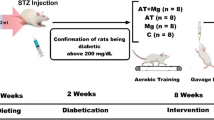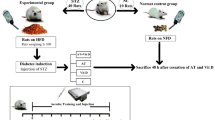Abstract
Introduction
Diabetes is one of metabolic diseases. In the patients with diabetes, glucose uptake is decreased and fibroblast growth factor 21 (FGF-21) plays an important role in glucose uptake. Also, Sirtuin 1 (SIRT1) is a protein regulating glucose and fat metabolism. Therefore, this study was performed to determine the effect of 12 weeks of exercises in water on serum levels of SIRT1 and FGF-21, glycemic index, and lipid profile in women with type 2 diabetes.
Materials and methods
For this purpose, 40 women with type 2 diabetes (with mean age of 43 years old and body mass index (BMI) of 31 kg/m2) were randomly divided into control (n = 20) and experimental (n = 20) groups. The exercise program was performed in water for 12 weeks, with an intensity of 45–65% of maximum heart rate. Blood samples were used for pre-test and post-test to evaluate serum levels of SIRT1 and FGF-21, glycemic index, and lipid profile. Then, data were analyzed using paired-samples t-test and independent-samples t-test at significance level of p < 0.05.
Results
The results of statistical analysis showed that the water exercise program significantly increased serum levels of FGF-21, SIRT1, and high-density lipoprotein cholesterol (HDL-C) in women with type 2 diabetes. In contrast, this type of exercise significantly reduced resistance to insulin, glucose, insulin, total cholesterol, triglycerides, and low-density lipoprotein cholesterol (LDL-C).
Conclusion
Based on results of the present study, it seems that exercise in water may play an effective role in glucose homeostasis and reduction of body fat mass, by increasing levels of SIRT1 and FGF-21 and it should be considered to prevent from development of type 2 diabetes. It can also be used as a type of exercise recommended by sports and health professionals in these people.
Similar content being viewed by others
References
HassanzadehGhahdarijani E, Sabohi F, Shirazi M. Comparison of vacuum-assisted closure therapy and modern dressing on wound healing in patients with diabetic foot ulcers. J Diabetes Nurs. 2020;8(4):1200–11.
Mohsenzadeh M, Aghaei F, Nameni F. The effect of high intensity interval training on SIRT1 and PGC1-α gene expression in soleus muscle of type 2 diabetes in male rats. Med J Tabriz Uni Med Sciences Health Services. 2020;42(4):447–55.
Vizvari X, Farzanegi P, Abbas ZadeSourati H. Effect of vigorous aerobic exercise on serum levels of SIRT1, FGF21 and Fetuin A in women with type II diabetes. mljgoums. 2018;12(2):1–6. https://doi.org/10.29252/mlj.12.2.1.
Colak Y, Yesil A, HuseyinMut H, Caklili O, Ulasogl C, Senates E, et al. A potential treatment of non-alcoholic fatty liver disease with SIRT1 activators. Review J Gastro intestin Liver Dis. 2014;23(3):311–9. https://doi.org/10.15403/jgld.2014.1121.233.yck.
Muller G. Microvesicles/exosomes as potential novel biomarkers of metabolic diseases. Diabetes Metab Syndr Obes. 2012;5:247–82. https://doi.org/10.2147/DMSO.S32923.
Gibala JM. Physiological adaptations to low-volume, high-intensity interval training in health and disease. J Physiol. 2012;590(5):1077–84. https://doi.org/10.1113/jphysiol.2011.224725\.
Saremi A, Shahrjerdi Sh, Kavyani A. The effect of aerobic training on metabolic parameters and serum level of Sirtuin1 in women with type 2 diabetes. Arak Medical University Journal (AMUJ). 2016;19(114):88–97.
Alamdari KA, Khalafi M. The effects of high intensity interval training on serum levels of FGF21 and insulin resistance in obese men. Iranian Journal of Diabetes and Metabolism. 2018;18(1):41–8.
Iglesias P, Selgas R, Romero S, Díez JJ. Mechanisms in endocrinology: biological role, clinical significance, and therapeutic possibilities of the recently discovered metabolic hormone fibroblastic growth factor 21. Eur J Endocrinol. 2012;167:301–9.
FasihiRamandi EL, Khaledi N. High intensity interval training induced changes in the hepatic FGF-21 gene expression and serum TNF-α in diabetic male rats. Bi-Quarterly Journal of Research in Sports Medicine and Technology. 2020;10(19):57–68.
Alizadeh L, Tofighi A, Tolouei Azar J. The effect of 8 weeks of high intensity interval training (HIIT) on Serum Irisin, FGF21 and glycemic indices in type 2 diabetic women. J Appl Health Studies in Sport Physiology. 2020;6(2):17–24.
Gaich G, Chien JY, Fu H, Glass LC, Deeg MA, Holland WL, et al. The effects of LY2405319, an FGF21 analog, in obese human subjects with type 2 diabetes. Cell metabolism. 2013;18(3):333–40.
Abasi A, Hedayatzadeh S, Abdi A, Abaszadeh H. The effect of eight weeks of aerobic exercise on FGF-21 serum, apolipoprotein A-1 and relative levels LDL/ HDL in obese women. Physiological research and management in sports. 2016;8(1):77–87.
Pacifici F, Di Cola D, Pastore D, Abete P, Guadagni F, Donadel G. Proposed tandem effect of physical activity and Sirtuin 1 and 3 activation in regulating glucose homeostasis. International Journal of Molecular Science. 2019;20(47):1–14.
Radak Z, Suzuki K, Posa Ac, Petrovszky Ac, IstvanBoldogh KE. The systemic role of SIRT1 in exercise mediated adaptation. Redox Biology. 2020;35(4):1–7.
Huang CC, Wang T, Tung YT, Lin WT. Effect of exercise training on skeletal muscle SIRT1 and PGC-1alpha expression levels in rats of different age. Int J Med Sci. 2016;13:260–70.
Suwa M, Nakano H, Radak Z, Kumagai S. Endurance exercise increases the SIRT1 and peroxisome proliferator-activated receptor gamma coactivator-1alpha protein expressions in rat skeletal muscle. Metabolism. 2008;57:986–98.
Sarga L, Nikolett H, Lauren K. Aerobic endurance capacity affects spatial memory and SIRT1 is a potent modulator of 8-oxoguanine repair. Neuroscience. 2013;252:326–36.
Besse-Patin A, Montastier E, Vinel C, Castan-Laurell I, Louche K, Dray C, et al. Effect of endurance training on skeletal muscle myokine expression in obese men: identification of apelin as a novel myokine. Int J obes (Land). 2014;38(5):707–13.
Yang SJ, Hong HC, Choi HY, Yoo HJ, Cho GJ, Hwang TG, et al. Effects of a three-month combined exercise programme on fibroblast growth factor 21 and fetuin-A levels and arterial stiffness in obese women. Clin Endocrinol (oxf). 2011;75(4):464–9.
Paneni F, Costantino S, Cosentino F. Insulin resistance, diabetes, and cardiovascular risk. Curr Atheroscler Rep. 2014;16(7):419. https://doi.org/10.1007/s11883-014-0419-z.
Soltani M, Rashidlamir A, Fathi M, Ghahremanimoghaddam M. The effect of eight weeks of water training on Sirt1, Pgc-1α and body fat percentage in obese men. J Babol Univ Med Sci. 2018;20(9):55–60.
Tolueiazar J, Tofighi A, Ghafari Gh. The effect of eight weeks of selected aerobic exercise in water on lipocalin levels, 2 glycemic indexes and lipid profile in middle-aged men with Overweight. Sports Life Sciences. 2019;11(3):299–314. https://doi.org/10.22059/JSB.2018.248017.1229.
Tolueiazar J, Tofighi A, Alizadeh R. The effect of high-intensity periodic training on serum levels of fibroblast growth factor, 21 Insulin resistance and lipid profile in inactive obese women. Sports Life Sciences. 2018;10(4):449–64.
Little JP, Safdar A, Wilkin GP, Tarnopolsky MA, Gibala MJ. A practical model of low-volume high-intensity interval training induces mitochondrial biogenesis in human skeletal muscle: potential mechanisms. J Physiol. 2010;588(6):1011–22.
Gurd BJ, Perry CG, Heigenhauser GJ, Spriet LL, Bonen A. High-intensity interval training increases SIRT1 activity in human skeletal muscle. Appl Physiol Nutr Metab. 2010;35(3):350–7.
Okoshi MP, Pagan L, Damatto R, Cezar M, Campos D, Lima A, et al. Physical training improves cardiac structure and function, antioxidant capacity, and exercise tolerance in spontaneously hypertensive rats. FASEB J. 2017;31((1Suppl)):838/6.
Moynihan KA, Grimm AA, Plueger MM, Bernal Mizrachi E, Ford E, Cras-Méneur C, et al. Increased dosage of mammalian Sir in pancreatic β cells enhances glucose-stimulated insulin secretion in mice. J Cell Metab. 2005;2(2):105–17. https://doi.org/10.1016/j.cmet.2005.07.001.
Munehiro K, Daisuke K. SIRT1 in type 2 diabetes: mechanisms and therapeutic potential. Diabetes Metab J. 2013;37(5):315–25. https://doi.org/10.4093/dmj.2013.37.5.315.
Oberbach A, To¨njes A, Klo¨ting N, Fasshauer M, Kratzsch Jr, Busse MW, et al. Effect of a 4 week physical training program on plasma concentrations of inflammatory markers in patients with abnormal glucose tolerance. Eur Jof Endocrin. 2006;154(4):577–85.
Kadoglou N, perrea d, iliadis f. Exercise reduces resistin and inflammatory cytokines in patients with type 2 diabetes. Diabetes Care. 2007;30(3):719–21.
Bello AI, Owusu-Boakye E, Adegoke BO, Adjei DN. Effects of aerobic exercise on selected physiological parameters and quality of life in patients with type 2 diabetes mellitus. Int J General Med. 2011;4(2):723–72.
Yoo HJ, Choi KM. Hepatokines as a link between obesity a cardiovascular diseases. Review Diabetes Metab J. 2015;39:10–5. https://doi.org/10.4093/dmj.2015.39.1.10.
Talanian JL ,Galloway SD, Heigenhauser GJ, Bonen A, Spriet LL. Two weeks of highintensity aerobic interval training increases the capacity for fat oxidation during exercise in women. J Appl Physiol. 2007;102:1439–47.
Cuevas-Ramos D, Almeda-Valdes P, Gómez-Pérez FJ, Meza-Arana CE, Cruz-Bautista I, Arellano-Campos O, et al. Daily physical activity, fasting glucose, uric acid, and body mass index are independent factors associated with serum fibroblast growth factor 21 levels. Eur J Endocrinol. 2010;163(3):469–77.
Taniguchi H, Tanisawa K, Sun X, Cao Z-B, Oshima S, Ise R, et al. Cardiorespiratory fitness and visceral fat are key determinants of serum fibroblast growth factor 21 concentration in Japanese men. The Journal of Clinical Endocrinology & Metabolism. 2014;99(10):E1877–84.
Kim HJ, Song W. Resistance training increases fibroblast growth factor-21 and irisin levels in the skeletal muscle of Zucker diabetic fatty rats. J Exerc Nutr Biochem. 2017;21(3):50–4.
Abbasi DA, Hedayatzadeh S, Abdi A, Abbaszadeh SH. The effect of 8 weeks of aerobic exercise on serum levels of FGF21, apolipoprotein A-1and LDL-c to HDL-C ratio in obese women. 2016;8(1):77–87
Kim KH, Kim SH, Min Y-K, Yang H-M, Lee J-B, Lee M-S. Acute exercise induces FGF21 expression in mice and in healthy humans. PloS one. 2013;8(5):e63517.
Tanimura Y, Aoi W, Takanami Y, Kawai Y, Mizushima K, Naito Y, et al. Acute exercise increases fibroblast growth factor 21 in metabolic organs and circulation. Physiological reports. 2016;4(12):e12828.
Kong Z, Sun S, Liu M, Shi Q. Short-term high-intensity interval training on body composition and blood glucose in overweight and obese young women. J Diab Res. 2016;2(16):1–9
Diaz-Delfin J, Hondares E, Iglesias R, Giralt M, Caelles C, Villarroya F. TNF-alpha represses betaKlotho expression and impairs FGF21 action in adipose cells: involvement of JNK1 in the FGF21 pathway. Endocrinology. 2012;153(9):4238–45.
Díaz-Delfín J, Hondares E, Iglesias R, Giralt M, Caelles C, Villarroya F. TNF-a represses –Klotho expression and impairs FGF21 action in adipose cells involvement of JNK1 in the FGF21 pathway. Endocrinology. 2012;153(9):4238–45.
Ghanbari-Niaki A, Saeidi A, Ahmadian M, Gharahcholo L, Naghavi N, Fazelzadeh M, et al. The combination of exercise training and Zataria multiflora supplementation increase serum irisin levels in postmenopausal women. Integr Med Res. 2018;7(1):44–52.
Acknowledgments
The authors would like to express their gratitude to all the subjects who participated in the training protocol.
Author information
Authors and Affiliations
Corresponding author
Ethics declarations
Ethics approval
This article has been approved by the ethics committee of the Iranian Institute of Physical Education and Sport Sciences and have an ethics code number SSRI.REC-2107–1165.
Consent for publication
An informed written EC was obtained from all the participants.
Conflict of interest
The authors declare that they have no known competing financial interests or personal relationships that could have appeared to influence the work reported in this paper.
Additional information
Publisher's note
Springer Nature remains neutral with regard to jurisdictional claims in published maps and institutional affiliations.
Rights and permissions
About this article
Cite this article
Gharakhanlou, B.J., Bonab, S.B. The effect of 12 weeks of training in water on serum levels of SIRT1 and FGF-21, glycemic index, and lipid profile in patients with type 2 diabetes. Int J Diabetes Dev Ctries 42, 727–734 (2022). https://doi.org/10.1007/s13410-021-01032-5
Received:
Accepted:
Published:
Issue Date:
DOI: https://doi.org/10.1007/s13410-021-01032-5




